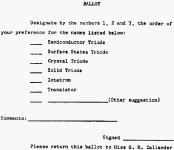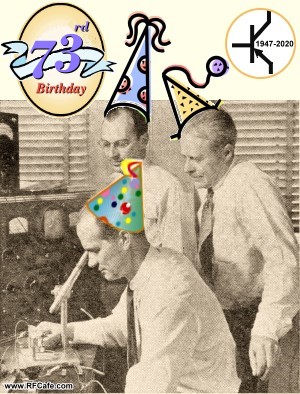|
May 1958 Radio-Electronics
 [Table
of Contents] [Table
of Contents]
Wax nostalgic about and learn from the history of early electronics.
See articles from Radio-Electronics,
published 1930-1988. All copyrights hereby acknowledged.
|
If you are reading this, then
chances are you owe a part of your livelihood to three gentlemen by the names of
Bardeen, Brattain and Shockley. On this day 73 years ago the trio announced their
discovery of a gain producing semiconductor device that they dubbed a 'transistor'
due to its dual nature as a transconductance amplifier and a variable resistance.
This article by magazine editor Hugo Gernsback, in celebrating the 10-year anniversary
of the transistor, mentions that somewhere in the neighborhood of 30 million of
the little miracle components would be sold that year. The microprocessor in the
device you are using to read this contains more than a billion. By comparison, the
'primitive' year-2000-vintage Intel Pentium 4 itself integrated more than the 30,000,000 transistors
sold in 1957.
|

Internal Bell Labs memo soliciting a name for the newly invented 'semiconductor
triode.'
|
Thanks to Adafruit's founder, MIT engineer
Limor "Ladyada" Fried
(photo to right), a copy of the original Bell Labs
internal memo (image to left) to solicit a name for
the new device is available. The choices offered were "Semiconductor Triode," "Surface
States Triode," "Crystal Triode," "Solid Triode," "Iotatron," and "Transistor."
Iotatron would have been very cool and futuristic sounding but inappropriate for
such a paradigm-changing invention. All forms that included 'triode' would have
been demonstrated an unwillingness to let go of the past's vacuum tube history.
'Transistor' descriptively captured the very essence of the device's functionality
and had the advantage of a sound almost as cool as 'Iotatron.' Had 'Iotatron' won,
we would today speak and write of the 'bipolar junction iotatron (BJI),' the 'field
effect iotatron (FEI),' have digital circuits made from 'iotatron-iotatron-logic
(IIL),' and listen to an 'iotatron radio.'
See the accompanying article "Ten Years
of Transistors."
Transistor Trends
Transistor Evolution Has Only Begun ...
By Hugo Gernsback

William Shockley, John Bardeen, and Walter
H. Brattain, co-discoverers of the transistor, received the 1956 Nobel Physics Award
for their invention. (Popular Electronics image) |
Before 1948 - a brief decade ago - the transistor was unknown. Electronics, with
a few exceptions, was based chiefly on the vacuum tube, which in various ways supplied
us with the indispensable stream of electrons for our instrumentation. Free "hot"
electrons were generated in incandescent filaments or heated cathodes, which had
their initial start in the Edison effect in 1883.
The transistor ushered in a new and revolutionary era which in many ways repeated
- and often excelled - the history of the vacuum tube. It did away with heated filaments
and cathodes and, consequently, with the cumbersome and uneconomic heating currents.
Instead of the vacuum tube's "hot" electrons, the transistor works with free, "cold"
electrons.
Nor does the transistor require the high voltages needed by the vacuum tube for
its best functioning. Less than 15 volts is required in the average transistor radio
set, as contrasted to the 115 to 300 volts of the vacuum-tube receiver.
Great as the transistor's progress has been to date, its evolution has but begun.
In the beginning, great difficulties in manufacture were encountered. Over 80% of
all assembled transistors were rejected. This trouble has now been mostly overcome
and the industry is settling down to mass production with smaller and smaller percentages
of rejections.
In 1955, when we produced only 12-3/4 million transistors - against 28-3/4 million
in 1957 - the present writer in the August, 1955, editorial ventured the opinion
that 50c (retail) transistors were on the horizon. (Vacuum tubes sold for 33c each
wholesale in 1955.) It is thus not surprising that recently a high-placed spokesman
of the industry predicted that 25c transistors are now a distinct possibility.
So far transistor production lags far behind vacuum-tube manufacture. The reasons
for this great disparity are simple. Vacuum tubes wear out and break. Transistors
are most rugged and so far no one has determined how long they will last. A probable
life may be 50 years. Hence, there may not be much of a replacement market for generations.
Further, transistor radios are still in the luxury class - they cost almost twice
as much as comparative vacuum-tube sets. Why? Being, as a rule, so much smaller,
they are more tedious to assemble and the miniature parts are more expensive, as
is the labor. This, however, is a transitory stage, familiar to the industry. The
day will come when good six- to eight-transistor sets will sell for around $10 -
not this" year or next, but in the foreseeable future. The reason for this forecast
is, of course, automation-mass production.
One of the reasons for the more than 100% manufacturing increase of transistors
last year is found in the flood of new types. In 1956 there were only about 275
transistor types. Now there are over 750! And this rapid increase will continue
for a long time.
New uses for transistors are found daily. Research in practically every endeavor
and art requires advanced and specialized types. This trend is increasing.
Take, for instance, space electronics. One cannot well imagine a modern rocket
or a satellite without a vast array of many types of transistors - all built with
an eye to shock-proof ruggedness, minimum weight and minimum dimensions.
From outer space to a defective beating heart may be a far jump, but it demonstrates
the ubiquity of the transistor. Recently, Dr. Folkman of Children's Medical Center
and Dr. Watkins of Harvard Medical School visualized how a defective heart block
could be corrected, thus saving the patient's life. They knew that a blocked ventricle
could be stimulated and made to contract electrically by applying electrodes to
it. An electrical consultant, C. F. Vanderschmidt, constructed a tiny R-C-coupled,
two-transistor amplifier. It amplifies the minute 5-millivolt auricular pulse into
an 0.5-pulse required to contract the ventricle.
A dog with a heart block was used for the first experiment. He was operated on
and electrodes sewn to the right auricle and left ventricle. Special insulated stainless
steel wire connected the heart electrodes to the amplifier, which in turn was firmly
attached to the dog's back. His recovery was uneventful and rapid. Subsequent improvement
in technique gave affected dogs a life of several months. It probably will not be
many years before humans with heart blocks, instead of resting in their graves,
will be walking the streets with tiny transistor amplifiers firmly strapped to their
chests.
Despite the 750 existing transistor types, here are a few important needed ones,
which are distinct future possibilities. Let us remember - the transistor has only
begun.
Atomic Transistors, frequently mentioned in this magazine, are technically feasible
and have been demonstrated in the laboratory. Such a type, when finally evolved
commercially, will make radio and television sets independent of batteries and outside
current supply. They will last for many years without attention. They will all be
truly portable and can be used and operated anywhere. Their upkeep will be minimal.
Transistor Picture Tubes. Today's television scanning tubes are of the cathode-ray
variety. To function, they must use a high voltage (15,000 and over) and the electron
beam must oscillate rapidly from side to side. In the future, it is almost certain
that the huge television picture tube of the present will not prevail. Already there
are a number of patents for thin and flat picture tubes. All of these, however,
still require high operating voltages.
We can imagine the future flat-thin TV picture tube, atom-transistor equipped
in which electroluminescence is used to produce the image. The entire screen is
made up of several hundred thousand electroluminescent points, all "steered" by
transistors. The latter, being atomic, supply a sufficient current to light the
screen vividly. There will be no moving ray, no motion at all. Only luminescent
points, lighting, extinguishing as necessary to create the image. Such a TV receiver
will be truly portable, even in a large screen size. Self-powered, it can be used
anywhere within reach of a TV transmitter. - H.G.
Posted June 25, 2020
(updated from original post on 12/16/2014)
|











